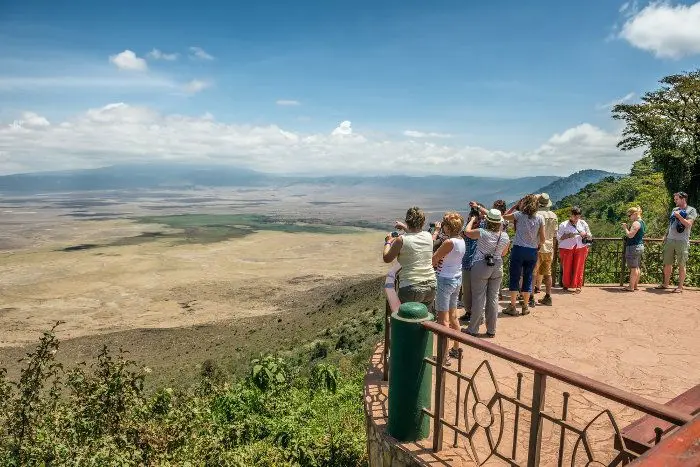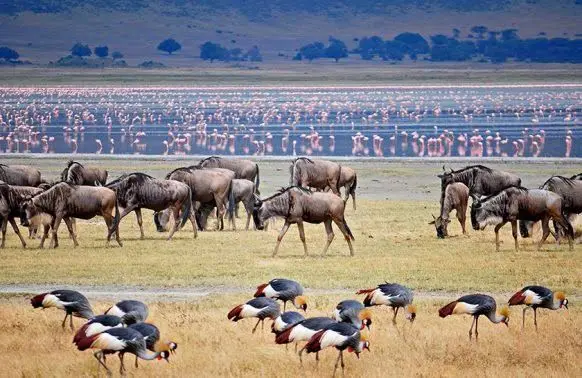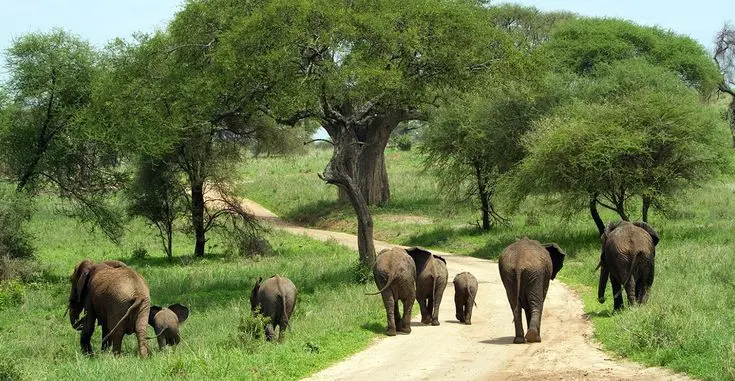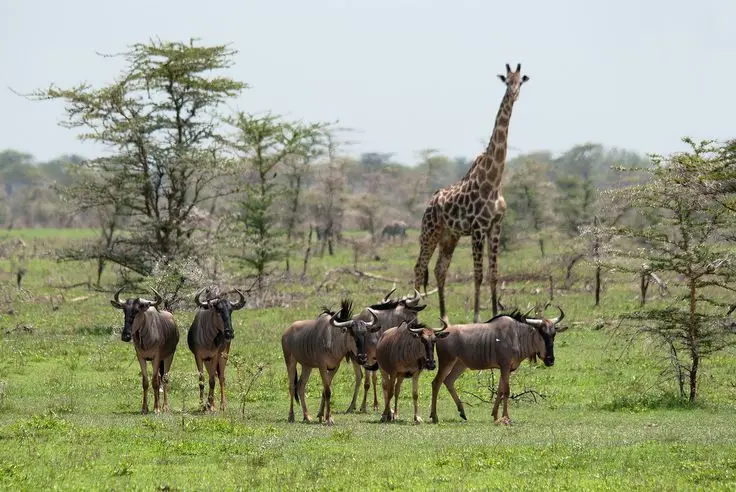Tanzania and Zanzibar Tourist Destinations & Attractions 2025
Tanzania and Zanzibar stand as Africa’s ultimate travel destinations, seamlessly blending raw wilderness, iconic wildlife viewing, rich cultures, scenic landscapes, and idyllic beaches. As the tourism sector records unprecedented growth in 2025, with Tanzania surpassing its 5 million-visitor target and Zanzibar welcoming over a million holidaymakers, the allure of these destinations has never been greater. Whether you seek the adrenaline of the Serengeti’s wildebeest migration, the serenity of Zanzibar’s powder-white beaches, or the intrigue of centuries-old Swahili towns, Nile Abenteuer Safaris welcomes you to an adventure that promises memories to last a lifetime.
Tanzania & Zanzibar at a Glance
Tanzania, spanning East Africa’s Indian Ocean coastline to the heart of the Great Rift Valley, is renowned for its untamed national parks, vibrant indigenous cultures, and UNESCO-listed heritage. Zanzibar, a semi-autonomous archipelago just off Tanzania’s coast, is famed as the “Spice Island,” boasting a unique fusion of African, Arab, and Indian cultures, pristine beaches, and a storied history that echoes through its winding Stone Town alleys.
The interconnected ecosystem between mainland Tanzania and its islands offers travelers an unparalleled combination of wildlife adventures and tropical relaxation. The following table summarizes the top destinations and highlights you can expect with Nile Abenteuer Safaris in 2025:
| Destination | Key Highlights | Signature Activities | Unique Appeal |
|---|---|---|---|
| Serengeti National Park | Great Wildebeest Migration, Big Five, Endless Plains | Game drives, balloon safaris, nature walks | Iconic safari, migration spectacle |
| Ngorongoro Crater | World's largest intact caldera, dense wildlife, Maasai culture | Game drives, crater rim walks, Maasai visits | High wildlife density, scenic vistas |
| Tarangire National Park | Massive elephant herds, baobab trees, birdlife | Game drives, walking safaris, birdwatching | Elephant paradise, less-crowded experience |
| Lake Manyara National Park | Tree-climbing lions, alkaline lake, flocks of flamingos | Game drives, canopy walk, birdwatching | Diverse habitats, unique lion behavior |
| Ruaha National Park | Rugged terrain, vast wilderness, large prides of lions, rare antelopes | Game drives, bush walks, birdwatching | Off-the-beaten-path, intimate wild experience |
| Selous Game Reserve | Water-based safaris, riverine landscapes, wild dogs, UNESCO site | Boat safaris, walking safaris, fishing | Untouched wild, boating safaris |
| Mount Kilimanjaro | Highest peak in Africa, diverse ecological zones, trekking challenges | 6–9 day summits via various routes | Bucket-list climb, panoramic summit views |
| Zanzibar (Unguja Island) | Powder-sand beaches, Stone Town, spice plantations, coral reefs | Beach relaxation, snorkeling, Stone Town tours | Exotic blend of culture and coastal beauty |
| Pemba & Mafia Islands | Undiscovered beaches, diving, marine reserves, whale sharks (Mafia) | Diving, snorkeling, cultural tours | Hidden paradises, marine wildlife |
| Bagamoyo | Swahili/Arab heritage, colonial architecture, arts scene | Historical tours, beach walks, art workshops | Authentic cultural immersion |
Each destination is discussed in detail below, providing insider insights, optimal travel periods, activities, accommodation tips, and key reasons why they should be on your itinerary.
Tanzania Tourism Overview 2025
Unprecedented Growth & Unmatched Experiences
2025 marks a watershed moment for Tanzanian tourism, with the country welcoming a record 5.36 million tourists, over 2.1 million of whom were international travelers, and the balance domestic visitors. Revenues have soared to nearly $4 billion, with government targets set at $6 billion by year’s end2. This surge is credited to the visionary leadership of President Samia Suluhu Hassan and successful global tourism campaigns, including high-profile film projects such as the “Royal Tour,” which has spotlighted Tanzania’s natural and cultural wonders to the world.
The diversity and richness of Tanzania’s attractions are its greatest USP. From the UNESCO-protected plains of the Serengeti and Ngorongoro Crater to the lesser-traveled southern circuit (Ruaha and Selous/Nyerere), travelers encounter a tapestry of landscapes, cultures, and wildlife. Recent trends highlight a growing preference among tourists for sustainable, community-driven experiences, revitalized cultural sites such as Bagamoyo, and eco-lodges that blend comfort with conservation.
For 2025, tourism segmentation is diversifying, as Tanzania promotes:
- Classic Big Five safaris
- Adventure tourism (Kilimanjaro, hot air ballooning, walking safaris)
- Beach and marine tourism (Zanzibar, Mafia, Pemba)
- Cultural heritage and festival tourism
- Photographic and birdwatching expeditions
The synergy between domestic and international tourism, coupled with significant infrastructure upgrades, assures that every traveler finds their dream adventure in Tanzania.
Zanzibar Tourism Overview 2025
The Jewel of the Indian Ocean
Zanzibar, comprising the main island of Unguja, Pemba, and a scattering of smaller isles, is experiencing phenomenal tourism growth. By mid-2025, the archipelago welcomed over one million visitors, with a 16.4% increase from the previous year and a rising influx of new source markets from across Europe, Asia, and Africa.
Key drivers of Zanzibar’s appeal:
- World-renowned beaches with turquoise waters, from lively Nungwi and Kendwa to tranquil Paje and ultra-exclusive Mnemba Island.
- Stone Town, a UNESCO World Heritage site brimming with Swahili, Arab, and colonial architecture, spice-scented markets, and boutique hotels.
- Cultural vibrancy, with annual festivals like Sauti za Busara and ZIFF fostering musical and artistic exchange.
- World-class diving and marine life, with Mnemba Atoll, Chumbe Island, and Kizimkazi offering encounters with dolphins and turtles.
- Expanding accommodation infrastructure, from luxury resorts and heritage townhouses to eco-friendly lodgings along the coast.
Recent investments also focus on sustainability, plastic-free beaches, solar-powered lodges, and community tourism initiatives now feature in the majority of new travel products.
Serengeti National Park
The Heartbeat of African Safaris
2025 brings a record number of visitors and global recognition to the Serengeti, cementing its status as Africa’s premier safari destination. The Serengeti’s reputation is built on its endless golden plains, the thunderous Great Wildebeest Migration, and its year-round population of the iconic Big Five.
Key Serengeti Highlights:
- The Great Wildebeest Migration: Every year, more than 1.5 million wildebeest, plus zebras and gazelles, journey clockwise across the Serengeti ecosystem in search of greener pastures. The migration peaks between June and October, with the dramatic Mara and Grumeti River crossings, prime for predator action and breathtaking photography.
- Exceptional wildlife viewing: The Serengeti boasts one of the world’s highest concentrations of lions and is home to leopards, cheetahs, elephants, buffalo, giraffes, and rare black rhinos. Over 500 bird species delight ornithologists.
- Hot air balloon safaris: Soaring at sunrise over the plains offers a magical, bird’s-eye view of wildlife and landscapes, concluding with a bush champagne breakfast.
- Diverse safari experiences: Options include game drives, mobile tented camps, luxury lodges, walking safaris, and cultural visits to authentically engage with Maasai communities.
- Seasonality: The dry months (June–October) are best for wildlife concentrations and clear skies; the green season (November–May) presents abundant young animals and lush grassy landscapes.
Signature SEO keywords: “Serengeti safari 2025,” “Great Wildebeest Migration,” “hot air balloon Serengeti,” “Big Five Tanzania,” “luxury Serengeti lodges.”

Ngorongoro Crater Conservation Area
Africa’s Eden
Often described as the “Eden of Africa,” the Ngorongoro Crater stands as the world’s largest intact caldera and delivers unparalleled wildlife density in a breathtaking volcanic amphitheater.
What to Expect:
- The crater floor, 260 sq. km in area, sustains approximately 25,000 animals year-round, virtually guaranteeing sightings of lions, elephants, leopards, buffalo, and the critically endangered black rhino.
- Birdlife: With over 500 species, including flamingos on Lake Magadi, the crater is a haven for birdwatchers.
- Cultural exploration: Gain insight into Maasai grazing traditions as the crater rim supports thriving indigenous communities.
- Olduvai Gorge: Unearth the story of human evolution at one of the planet’s most significant anthropological sites.
Best time to visit: The dry season (June–October) provides the best visibility and wildlife concentration, while the wet season turns the basin into a lush, flower-strewn oasis, perfect for birding and fewer crowds.
Accommodation: Choose from luxury lodges on the rim (e.g., &Beyond Ngorongoro Crater Lodge) or mid-range and budget options near Karatu.

Tarangire National Park
Elephant Paradise & Baobab Wonderland
Awarded Africa’s Leading Elephant Paradise in the 2025 World Travel Awards, Tarangire National Park is among Tanzania’s most rewarding hidden gems.
Key Features:
- Massive herds of elephants: Especially during the dry season (June–October), Tarangire’s lifeline river draws herds numbering in the hundreds.
- Baobab landscapes: Iconic ancient trees dotting the savannah create a photogenic and atmospheric safari backdrop.
- Diverse wildlife: Lions, leopards, cheetahs, giraffes, and over 500 bird species, including endemic and migratory flocks.
- Exclusive, uncrowded safaris: With fewer vehicles and visitors, the experience feels more intimate than neighboring parks.
- Active adventures: Walking safaris, night game drives, birding tours, and cultural visits to Maasai and Barbaig communities.
Lake Manyara National Park
Tree-Climbing Lions & Flamingo Spectacles
Though compact, Lake Manyara National Park offers extraordinary biodiversity and the chance to witness wildlife found nowhere else.
Highlights:
- Unique tree-climbing lions: A rare behavior observed primarily in Lake Manyara, these iconic cats rest on acacia branches to escape heat and insects.
- Lake Manyara’s alkaline flats: Pink clouds of flamingos and countless other waterbirds line the shimmering shores at various times of year.
- Elephant herds, baboons, giraffes, and hippos: The park’s evergreen groundwater forest, open plains, and steep rift valley escarpment accommodate a tapestry of habitats and animals.
- Adventures: Canopy walks, night game drives, canoeing (seasonal), and cycling excursions.
- Cultural interactions: Maasai village visits and craft markets.
Best visited from June to October (dry season) for optimal wildlife visibility, though birding is excellent November through July.

Ruaha National Park
Tanzania’s Last Untamed Wilderness
As the largest national park in Tanzania and among the wildest in East Africa, Ruaha delivers an authentic, off-the-beaten-track safari for adventurous travelers.
Why Choose Ruaha?
- Massive elephant and buffalo herds: Ruaha supports over 10,000 elephants and huge populations of buffalo, making it ideal for big game enthusiasts.
- Predators galore: About a tenth of the world’s lion population, healthy numbers of leopards, cheetahs, and rare African wild dogs.
- Rare antelopes: Sable, roan, greater kudu, and others thrive here, alongside over 450 bird species.
- Scenic diversity: Rolling hills, rugged gorges, sand rivers, and ancient baobabs offer a dramatic landscape.
- Low visitor density: Intimate encounters, extensive bush walks, and fly camping for a close-to-nature feel.
Recommended for: Second-time safari travelers, birdwatchers, photographers, and anyone seeking remote, exclusive wilderness.
Best time: The dry season (June–October) concentrates wildlife at remaining water sources; the green season is lush, beautiful, and excellent for birds.

Selous Game Reserve (Nyerere National Park)
Water Safaris & Wild Spirit
A UNESCO World Heritage Site, Selous, now officially Nyerere National Park, is famed for its vast wild interior, river-based adventures, and remarkable biodiversity.
Must-Do Experiences:
- Boat safaris on the Rufiji River: See hippos, crocodiles, and vibrant birdlife from the water, a unique advantage over other parks.
- Walking safaris and fly camping: Get closer to nature with guided treks and nights under the stars.
- High wildlife density: Elephant, large prides of lion, leopard, African wild dogs, and diverse antelope species.
- Varied landscapes: Miombo woodlands, palm forests, wetlands, lakes, and open plains.
- Remote and peaceful: The park’s sheer size means you can go hours without seeing another vehicle.
Ideal for: Adventurers, honeymooners, and those interested in a “southern circuit” combo with Ruaha or coastal Zanzibar escapes.

Mount Kilimanjaro
Summit the Roof of Africa
Towering at 5,895 meters (19,340 feet), Mount Kilimanjaro is Africa’s highest peak and one of the Seven Summits, drawing adventurers and trekkers from around the globe.
Essential Kilimanjaro Trekking Facts:
- Seven major climbing routes: The Machame, Marangu, Lemosho, Rongai, Northern Circuit, Shira, and Umbwe routes each offer distinct scenery, duration, and difficulty. Lemosho and Machame are most recommended for their scenic diversity and acclimatization success rates.
- All climbs are guided: Tanzanian law requires certified guides for all summit attempts.
- Journey through five ecological zones: Trek from rainforest to moorland, alpine desert, to the glacier-capped summit.
- Best times to climb: January–March and June–October, when the weather is dry and views are clear.
- Options for every fitness level and experience: Choose from 5-day Marangu routes to 9-day Northern Circuits, with more days translating to higher success rates and better acclimatization.
- Bucket-list achievement and panoramic views: Witnessing sunrise from Uhuru Peak ranks among the world’s top travel experiences.
Main Cultural Sites on Mainland Tanzania
Cultural immersion is key to a well-rounded Tanzanian experience. Mainland highlights include:
- Bagamoyo: Once a major Swahili, slave, and ivory port; today a UNESCO World Heritage Site in progress with restored colonial buildings, arts festivals, dhow-building workshops, and bustling fish markets.
- Arusha & Moshi: Bustling gateway cities offering Maasai market visits, coffee tours, and local delicacies.
- Lake Eyasi & Hadzabe/Hadza communities: Experience the lifeways of Tanzania’s last hunter-gatherers.
- Numerous villages and conservation areas: Many safaris include Maasai boma experiences, craft workshops, traditional dances, and culinary discoveries.
Zanzibar’s Cultural Attractions & Festivals
Stone Town is the centerpiece of Zanzibar’s cultural offerings, its labyrinth of alleys alive with the scent of cloves, spice bazaars, bustling markets, ornately carved doors, and centuries-old mosques and churches. Top sites include the House of Wonders, Forodhani Gardens (and nighttime street food market), Old Fort, Sultan’s Palace, and Freddie Mercury’s birthplace.
Annual festivals light up the archipelago:
- Sauti za Busara: February’s festival brings together musicians from across Africa.
- Zanzibar International Film Festival (ZIFF): July releases over 100 films under the stars in Stone Town.
- Mwaka Kogwa: Shirazi New Year festival with mock banana-stem battles in Makunduchi.
- Numerous art shows, cultural workshops, and culinary events inject vibrancy into every season.
Spice Tours, Dhow Cruises, and Cooking Classes: Dive deeper into Zanzibar’s heritage with hands-on spice farm experiences, sunset yacht outings, and Swahili cuisine lessons.
Zanzibar & Tanzania’s Best Beaches in 2025
Zanzibar’s Top Beaches
Zanzibar’s beaches are legendary for their powdery sands, swaying palms, and turquoise waters, ranked among the finest in the world. Here are the unmissable beaches for 2025:
- Nungwi (North): Calm, swimmable at all tides, packed with luxury resorts, lively bars, and watersports.
- Kendwa (North): Famous for its uninterrupted swimming, sunset views, and relaxed, romantic vibe.
- Paje (East): Kitesurfing hotspot with a bohemian buzz and excellent beginner schools.
- Mnemba Island (North-East): Exclusive private island for snorkeling, diving, and high-end luxury.
- Nakupenda (Off Stone Town): Pristine sandbank for day trips and picnics.
- Matemwe, Jambiani, Kizimkazi: Secluded escapes, turtle conservation, and dolphin watching.
- Pemba & Mafia Islands: Off-the-beaten-path, world-class diving, whale shark encounters (Mafia), and untouched coral reefs.
Water Activities: All beaches offer opportunities for snorkeling, scuba diving, dhow sailing, paddleboarding, sunset cruises, and deep-sea fishing.

Scenic Landscapes & Unmissable Natural Wonders
Tanzania’s allure goes beyond wildlife, its natural wonders are unrivaled:
- Lake Natron: The world’s principal lesser flamingo breeding site, its pink tides and harsh beauty are best seen June–October, with additional trekking to Ngare Sero Falls and Ol Doinyo Lengai volcano for the intrepid.
- Udzungwa Mountains: “African Galapagos,” a biodiversity hotspot for hiking and birding.
- Usambara Mountains: Lush highland scenery, tea estates, and eco-lodges.
- Rift Valley vistas: Dramatic escarpments, crater lakes, and ancient baobab forests abound at every turn.
Adventure Activities Across Tanzania & Zanzibar
For thrill-seekers, Tanzania offers a playground of adventure:
- Hot air balloon rides: Sunrise flights over the Serengeti, Tarangire, or Ruaha for epic aerial perspectives.
- Walking safaris: Guided hikes in Selous, Ruaha, Tarangire, and Serengeti for up-close animal tracking.
- Mountain biking, horseback riding, canoeing, and deep-sea fishing: Exciting ways to discover less-trodden paths.
- Dhow cruises and kitesurfing: Iconic Zanzibar experiences.
- Diving and snorkeling: Explore coral reefs at Mnemba, Chumbe, Mafia, and Pemba.
- Cultural immersion: Maasai boma visits, spice tours, craft markets, local cooking workshops.
- Volunteering and eco-initiatives: Beach clean-ups, community tourism, wildlife conservation.
Climate & Best Time to Visit Tanzania & Zanzibar
Understanding the climate is essential to maximize your adventure experience:
- Dry Season (June–October): Cooler temperatures, minimal rainfall, perfect for safaris, Kilimanjaro climbs, and beach visits. This is peak tourism season; book early!
- Green Season (November–March): Short rains (Nov–Dec) bring vibrant landscapes and abundant migratory birds. Excellent for birding and photography. December–February remains hot and relatively dry.
- Long Rains (March–May): Heavy rainfall in some regions—lower accommodation prices, fewer crowds, lush scenery, but some properties on Zanzibar may close temporarily.
Zanzibar enjoys a tropical climate year-round, with average daytime highs of 29–33°C. The Indian Ocean stays warm (25–29°C), offering pleasant swimming through every season. Be mindful of the “long rains” (April–May) if seeking uninterrupted sunshine.
Kilimanjaro climbing best times: January–March and June–October for stable weather and clear summit views.
Travel Tips & Practical Information for Tanzania & Zanzibar
Entry & Visa Requirements
- Visa: Most travelers require a tourist visa, easily obtained online (e-visa), upon arrival, or via consulate. Costs range from $50 (single entry) to $100 (multiple entry, US citizens).
- Citizens from 60+ countries, including Kenya and South Africa, enjoy visa-free access for up to 90 days.
- Yellow fever vaccination: Proof required if arriving from or transiting through endemic countries.
Health & Safety
- Malaria prophylaxis: Recommended, especially for mainland and coastal regions.
- Vaccinations: Routine vaccines plus hepatitis A/B, typhoid, and tetanus suggested.
- Travel insurance: Highly recommended for medical emergencies, evacuation, and COVID-19 coverage.
Getting Around
- Mainland: Domestic flights, high-quality safari vehicles, and authorized guides essential for wildlife areas.
- Zanzibar: Direct international flights, fast ferry from Dar es Salaam, taxis and transfers between beaches, car hire for independent exploration.
Money & Payments
- Currency: Tanzanian shilling (TZS). US dollars are no longer widely accepted in hotels and for park fees.
- ATMs & cards: Available in major towns and resorts. Carry some cash for rural/remote purchases.
Dress & Culture
- Modest clothing: In Zanzibar and mainland coastal regions, respectful dress is appreciated, especially in villages and Stone Town.
- Beachwear: Absolutely fine on beaches and resorts; a cover-up is recommended for town scenes.
- Local customs: Greetings are important; always ask before photographing people.
Accommodation & Hospitality: From Luxe to Local
Tanzania and Zanzibar offer a full spectrum of stays, from five-star suites to eco-lodges and family guesthouses:
- Luxury safari lodges: Four Seasons Serengeti, &Beyond Ngorongoro Crater Lodge, Singita, Selous Serena Camp, Ruaha’s Jabali Ridge.
- Boutique lodges & tented camps: Lemala, Elewana, Tarangire Safari Lodge, Ikoma Wild Camp.
- Mid-range & budget: Acacia Camps, Panorama Safari Camp, Marera Valley Lodge, Rhino Lodge.
- Zanzibar luxury: Zuri Zanzibar, Baraza, Zawadi, Xanadu, Residence Zanzibar, Mnemba Island Lodge.
- Boutique hotels in Stone Town: Emerson on Hurumzi, Upendo House, Zanzibar Serena Inn.
- Family & budget: Pongwe Beach Hotel, Jambiani guesthouses, Marera Valley Lodge, and hostels.
Pro travel tip: Book at least 6–9 months in advance for peak season travel (June–October) and for unique safari lodges or exclusive boutique beach properties.